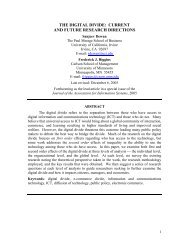When Should Software Firms Commercialize New Products ... - MISRC
When Should Software Firms Commercialize New Products ... - MISRC
When Should Software Firms Commercialize New Products ... - MISRC
You also want an ePaper? Increase the reach of your titles
YUMPU automatically turns print PDFs into web optimized ePapers that Google loves.
1 Introduction<br />
Efficient diffusion of a product innovation represents a challenge faced by many firms in<br />
the software industry. Conventional models, whereby the entire product or each sepa-<br />
rate module comes with an associated price, represent a legacy of the early stages of the<br />
software industry that still endures to the present day (e.g., various versions of Apple or<br />
Microsoft Windows operating systems). Nevertheless, the software market infrastructure<br />
and ecosystem have experienced a sea change over the past couple of decades. On one<br />
hand, information technology performance-to-price ratio increased significantly and user<br />
interfaces became much more friendly, accelerating the adoption of computers towards sup-<br />
porting activities on both professional and personal levels, which, in turn, led to software<br />
becoming ubiquitous to the functioning of our society. According to Datamonitor (2009),<br />
the size of the rapidly growing global software market was $303.8 billion in 2008 and is<br />
estimated to reach $457 billion by 2013. On the other hand, Internet penetration and usage<br />
grew at a staggering rate, with current statistics reporting over 1.96 billion Internet users<br />
and over 681 million interconnected Internet hosts worldwide (Internet World Stats 2010,<br />
ISC 2010). This led to the emergence of online software distribution models (e.g., online<br />
software marketplaces such as Apple App Store, Google Apps Marketplace, Microsoft on-<br />
line store, or repositories such as SourceForge.net), online software consumption models<br />
(e.g., software-as-a-service offerings such as Salesforce.com CRM suite or GE’s Centricity<br />
Electronic Medical Records service), as well as online feedback models that strengthen the<br />
word-of-mouth effects (Dellarocas 2003).<br />
Inresponsepartlytothisparadigmshift,anewsoftwarebusinessmodel,calledfreemium<br />
(Anderson2009), hasemerged, combining“free”and“premium”consumptioninassociation<br />
with a product or service. In a nutshell, the model involves giving away for free a certain<br />
level or type of consumption while making money on premium consumption. Freemium<br />
models are spreading quickly in the software industry, especially among Web start-ups<br />
(Miller 2009).<br />
Twoof the most commonly encountered freemiummodels arefeature-limited freemiums<br />
(FLF) and time-limited freemiums (TLF) (Anderson 2009, p. 245). FLF models involve<br />
offering a basic version of the product with limited functionality for free, while charging for<br />
additionalfeaturesinthepremiumversion. Yahoo! forexample, offersbasicemailservicefor<br />
2
















